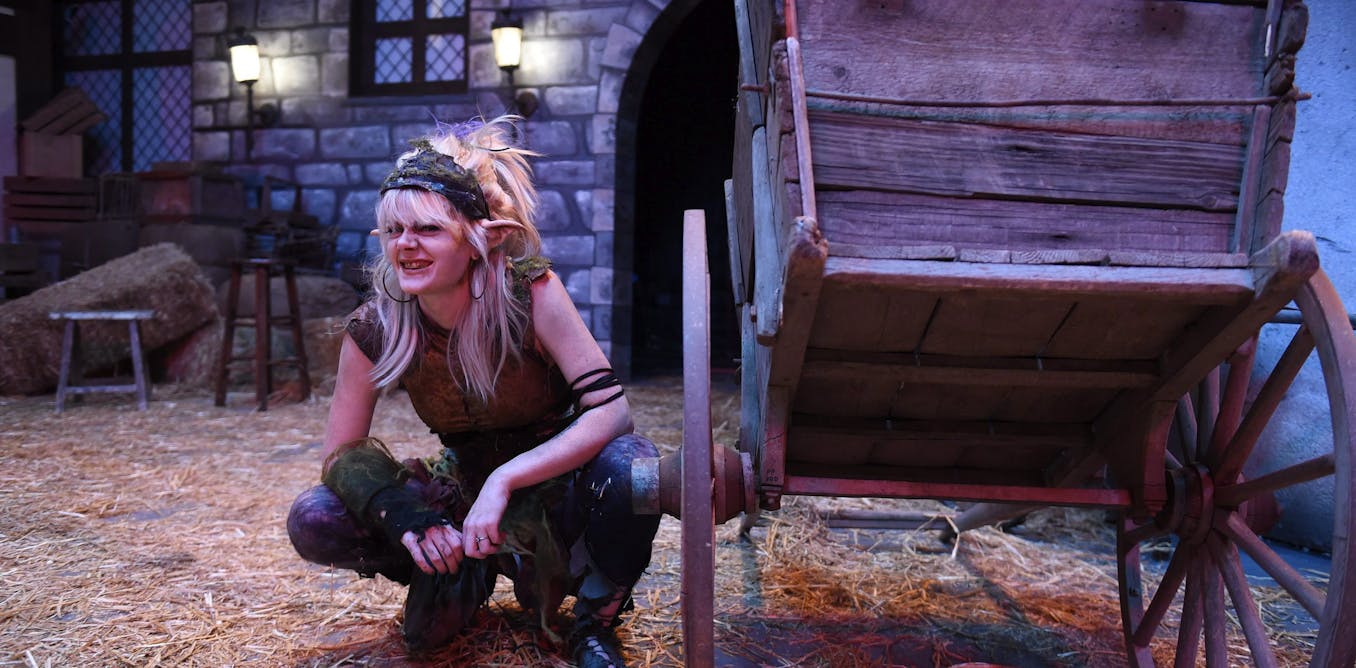In India, a 5,000-year-old tradition of using disposable clay cups, known as kulhads, for serving hot beverages like chai and desserts like yogurt still persists today. These biodegradable cups have been excavated from the Indus Valley dating back to the end of the Stone Age. Despite the availability of cheaper and more convenient options like plastic and paper cups, kulhads are still favored by many for their unique earthy flavor that comes from the clay seeping into the hot liquid.
The cost per kulhad is typically around 1 rupee, or .01 USD, and each cup is handcrafted in harsh conditions that take a toll on the artisans. While some argue that kulhads are a healthier and more environmentally friendly option compared to synthetic materials, there is still debate over the scientific evidence supporting this claim. To get a closer look at the traditional clay cup business, we visited a kulhad workshop outside of Kolkata to see firsthand how these cups are made and why they are still standing strong in the market.
As consumers become more environmentally conscious and look for sustainable alternatives to single-use plastics, the age-old tradition of using clay cups like kulhads may see a resurgence in popularity. The cultural and historical significance of these cups, combined with their potential health and environmental benefits, could position them to compete with modern disposable cup options in the future. Only time will tell if India’s 5,000-year-old tradition of using clay cups will continue to thrive alongside plastic and paper alternatives in the market.
Watch the video by Business Insider
Video “Can India’s 5,000-Year-Old Disposable Clay Tea Cups Compete With Single-Use Plastic?” was uploaded on 11/20/2024 to Youtube Channel Business Insider







































If you truly believe that plastic bags, straws and cups are the problem, you're sadly uninformed.
Go ahead and ban them all. You'll change nothing.
Edit: I'm wrong. You'll make yourself feel like you did something good. That's all that matters, right?
No.
The transportation cost of these heavy cups override any benefits
0:56 the heart attack I almost had 😅
Just start collecting the cups, break them down to dust again and reuse them to make new clay and start over. You'll beed some new clay each time, but you'll save a ton in the long run.vplus youll help reculycle, save money, make more money, and help the mini cup market.
Are these cups microwaveable ?
Kulhad tea is costly in metro cities of India as the taste becomes altogether different. And it is biodegradable, but it takes more time in weathering as compared to say, a banana peel. However, many times the cracked kulhads are used in other industries.
For some talking about lack of recycling in India, please do know India has one of the recycling ratio among the bigger economies, not because of infrastructure, but because the poor would not let anything go to waste. It’s not something to brag about, but sufficiently said, India is able to recycle to a great deal and thus west should worry about its share of climate change contributions and even more about the deniers!
As long as it doesn't contain Lead then I will buy them over those beautiful painted cups
There’s nothing to compete with once modern society gets smart they will naturally seek out clay cups
I can’t imagine that anybody who is concerned about the environment would be a proponent of these single use clay cups. The amount of thermal energy required to go from clay – ceramic is definitely more than the energy required to make petro-plastics or paper. And the thermal energy methods they use in India are about as pollutant-heavy as they get.
It looks hard but at least not too dangerous. It’s wet so no silicosis and non toxic. Can’t say that bout a lot of Indian industry. I’d love to drink tea from their cups to support them. ❤
I may be stupid but….. can't they be washed? If those trash collectors are gathering them, and the potter needs back stock, seems like just washing them would be efficient, right?
Why not recycle them? Tea sellers could have a bin only for the kulhads and sell them back to the makers to ground them for base material.
Why doesn't anyone make a business collecting them and washing them. Selling them back to the shops for the cost of the paper cups.
What a disgusting tradition. Unsanitized dirt and clay baked at relatively low temperature then handled and transported, not sealed only to be poured with liquid without any coating at all. Yea these cups are a biohazard for sure. Then again almost everything in India is riddled with bacteria and microbes so it is not surprising. Gross.
Four great reasons to use the kulhads: (1) fired clay and water wash just before pouring tea adds a subtle petrichor smell to the beverage enhancing the experience, (2) the clay insulates fingers from the heat and provides a cool, strong and textured (yet lightweight) surface, (3) use-and-throw keeps them hygienic, and (4) these are literally dirt cheap.
They are high in cadmium and mercury. Don't ever drink hot beverage in these clay cups.
THANKS A LOT TO BUSINESS INSIDER FOR BRING THIS UP.
SERIOUSLY, WHEN WE GO OUT TO DRINK SOME TEA OUTSIDE IN OUR AREA IN KOLKATA, THERE ARE LESS TEA SHOPS WHO SELL TEA IN THE BHARS, ASKING THE REASON THEY SAID THAT THE PRICES HAS GONE UP AND THE PEOPLE MAKING THEM HAS DWINDLED IN NUMBER. WE HAVE TO RESORT FOR THE PAPER CUPS. TEA IN A BHAR CAN'T BE COMPARED WITH OTHER MATERIALS.
Drinks in the plastic cup just wouldnt taste the same. If you are a food business, and you customers have a problem with the taste, then you have a serious problem on your hands.
Everyone know why you choose that thumbnail business insider
Nothing like some feet in my tea.
100% good product from India Bengal . Nice to see their hard work.
Now we want a video on Kulhhad chai😂
So many indian engineers and no one managed to automate and make this things safer😂
Why throw the clay cups away ?
Someone has a good business opportunity to hear,
If collected for recycling!!
Could be reused for seed pots,
Could be painted on and sold to toursist!!
Could be washed and dried sold to the crafting industry's ect ect
It is so sad to see blood swet and tears go in the bin like that. Hey, you could even use them for candle holders!
The endless possabiltys hear is mindblowing 😢
How tf you gonna compare a fuqin dirt cup and plastic cup on their "not so eco friendly" effects on the environment…..
For those who can, we should start promoting earthen cups and pots whenever possible.
It's negligible for the entire industry but I use earthen pots and plates made out of banana+sal trees during family occasions. Trust me, the guests love it!
Needs a little more budget and effort frommy end but worth it!
Waiting for all the couch hygiene experts to come to the comments.
What this cup shop need is some automatization. For example some sort of mixer for clay and maybe separator which would remove heavier particles like stones. That's why those people are suffering and west is prospering. Such intense manual labour is the thing of the past, only craftsmen are allowed to exist in modern capitalist system competitively.
In my opinion those can be sold in Flipkart. This is the best option for them.
Why so obsessed of india ?? Making eveytime a video dont u have content.. all the people here know how to hate
This type of business will revive in future when India per capita income increases and people spending power increases as it seems all over the world people start to give more emphasis on cultural value as their income increases particularly in Asian countries where they have a history of more than 5000 years.
To unsanitary for me I'll stick to plastic
If I lose my mind and go to India
Well seeing as how they have to make sure they use their foot in every step of the manufacturing processes making sure to season the clay throughly with foot particles… I’m going to say no I’d rather have a clean cup with extra clean microplastics and one time use when it comes to plastic isn’t one time use…. is it?
Coool-haad😂
They are used as they come, unwashed or wiped clean.. that's the only thing bothering me, otherwise tea tastes better with those than plastic or paper cups
I still drink tea from bhar every day. Glad its still here.
Trust me , taste of tea in kulhad is completely different and tastes so much better than anyother utensils.
I had tea in one of these cups on the banks of the Ganges. Instead of throwing it away I took it all the way back home to Australia, it is my prized possession from the trip.
no is the simple answer ….
Trademark of India's food/goods videos:
1) Must show lots of actions & patterns
2) Must waste ingredients
3) Mostly use bare hands
4) Utensils are darker than my armpit
5) Honking everywhere
6) Hygienic is criminal in India and a sin to Brahma and Vishnu
Mass production.
I didn't suprise to see some mans foot in production. I think they obsessed to do something with their foot.
Please don't let this teacup die.
in this video ; does indentured labor compete with automation?
I LOVE KULHADS
Its getting opposite now, atleast in my area more prominent tea shops are mostly using these instead of paper cups.. good for people as well as environment.. being made of clay also helps it transfer heat slowly, so your hand does not burn..
Finally Business Insider comes to Kolkata! There are more traditional industries here that you can cover.
just use edible cups smh